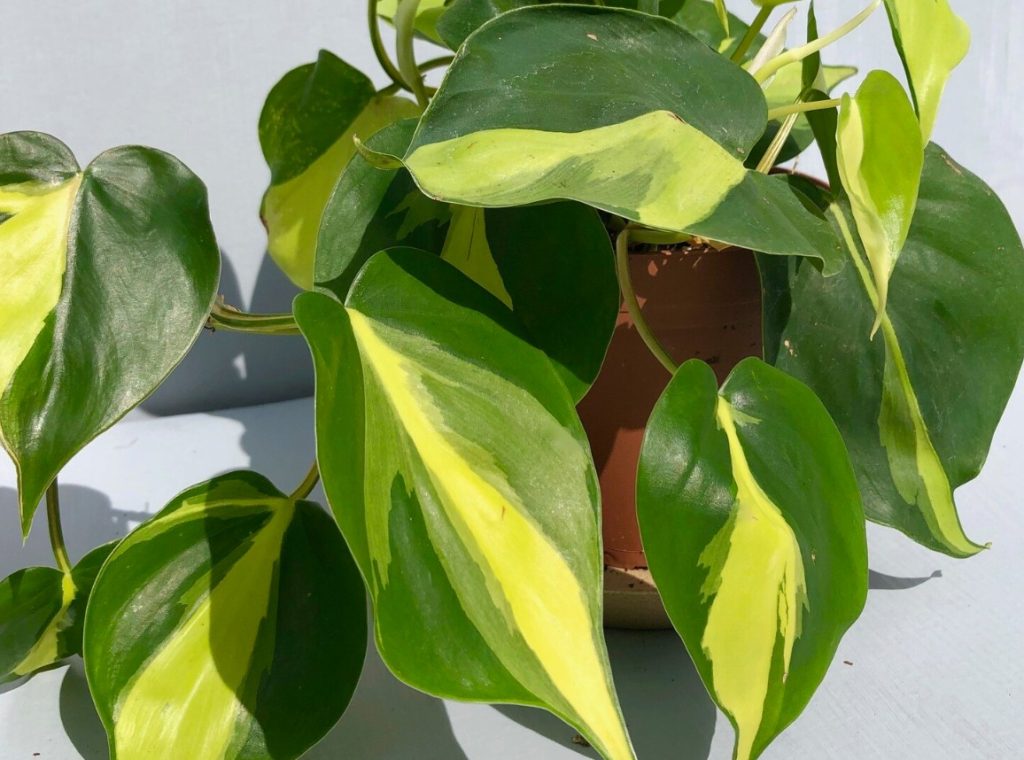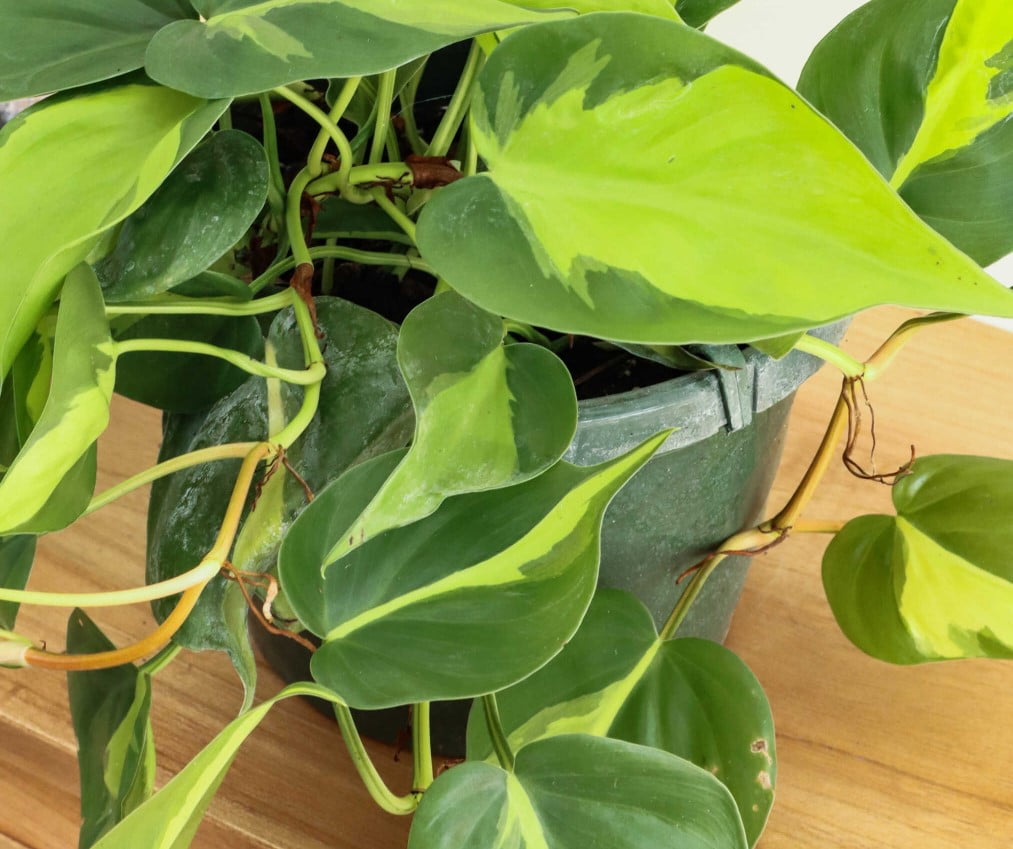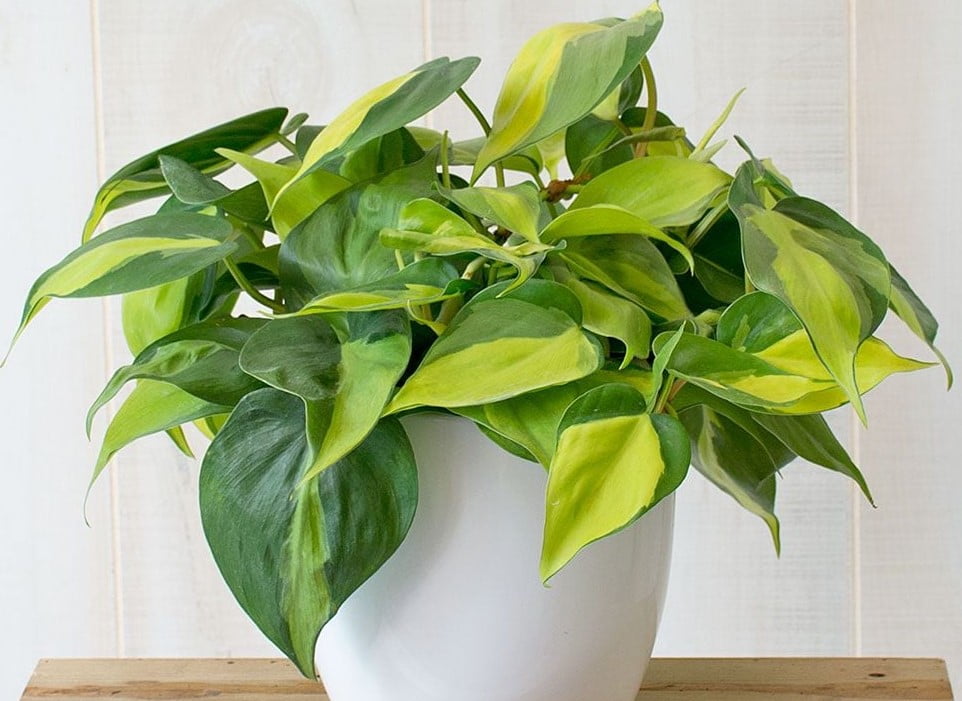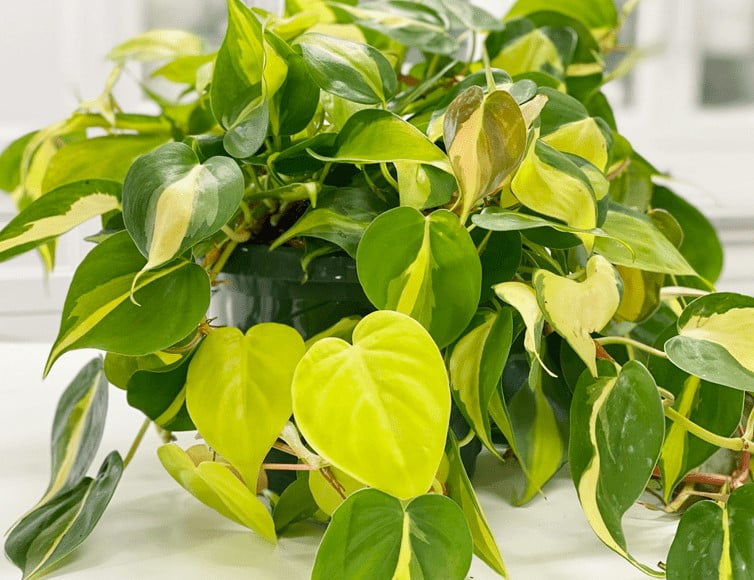Welcome to the wondrous world of Philodendron Brasil! This stunning tropical plant is sure to add major style to your indoor jungle. This plant has pretty green leaves shaped like hearts, and some parts of the leaves are a bright light green color. It’s like having a little piece of the jungle where Brazil is, right in your house!
The Philodendron Brasil is a special kind of plant that comes from South America. It’s easy to take care of if you know how to do it right. If you follow the steps in a guide, your plant will grow big and pretty. It can hang down from a basket or climb up a stick covered with moss.
Here’s what makes this philodendron variety so special:
The Philodendron Brasil is from the rainforests of Brazil and loves warm, humid places. Recreate these steamy conditions at home for optimal growth.
Variegated foliage: The leaves feature dark green coloration with bright lime green splotches. This variegation adds visual interest and dimension. Provide bright, indirect light to bring out the best coloration.
Philodendron Brasil can be grown in a hanging basket or trained up a support. It has long trailing stems or climbing aerial roots. Its vining growth habit adds versatility.
Philodendron Brasil, like other houseplants, purifies indoor air and removes toxins. Its large leaves can help freshen your living space.
Want to Caring for Your Philodendron White Princess? Read The Complete Guide here.
Now that we know the basics, let’s look at how to grow Philodendron Brasil successfully.
Care and Growing Condition for Philodendron Brasil
Light Requirements
When it comes to proper light for Philodendron Brasil, moderation is key. This tropical plant thrives in bright, indirect sunlight that is neither too intense nor too dim. Read on for more details on lighting this gorgeous houseplant.
Philodendron Brasil relishes being in a spot with ample ambient brightness. A location near an east, west, or north window provides the right amount of light. Some dappled sun in the morning or evening is fine, but avoid prolonged direct sunlight which can scorch the leaves.
The variegated varieties need sufficient light to maintain the lime green patterns on the leaves. Insufficient light causes the spaces between the veins to fade to a solid green color. To keep the mosaic-like variegation vibrant, provide at least 4 hours of bright, filtered light per day. An east or west-facing window is ideal.
Too much light can also be problematic. Direct hot sunlight and intense southern exposure can burn the leaves, causing brown crispy spots and damage. Filter the light with a sheer curtain to prevent leaf burn. Leaves may start to curl or fold if light levels are too high.
On the other end of the spectrum, low light results in sparse, weak growth. The stems become long and leggy as the plant reaches for light. Smaller leaves may drop off entirely. Supplement with a grow light if ambient light in the room is low.
Observe the plant’s growth patterns and adjust the lighting as needed. The Philodendron Brasil will grow well if it gets enough indirect sunlight. Its foliage will be variegated and healthy.
Watering
Providing the right amount of water is key to keeping your Philodendron Brasil healthy and thriving. Learning how to properly irrigate this tropical plant will help you avoid issues like root rot and drooping leaves.
How Often to Water
Philodendron Brasil should be watered once the top few inches of soil have dried out. Use your finger to test the soil moisture before watering again. This usually translates to watering about once per week in the growing season.
Reduce watering frequency in the winter when growth slows. Wait until the top 50% of the soil is dry before watering again. The plant may only need water every 2-3 weeks in the winter.
Watering Method
When watering, drench the soil completely until water drains from the drainage holes at the bottom of the pot. This ensures the entire root zone gets hydrated. Avoid just dribbling water over the top of the soil, as this leads to shallow roots.
Signs of Underwatering
If you wait too long between waterings, the leaves may start to droop or curl. The plant may also shed some of the older leaves near the base. Water thoroughly if you notice these symptoms of underwatering.
Signs of Overwatering
On the other hand, soggy soil can cause root rot and other problems. Signs of overwatering include yellowing leaves, mushy stems, and leaf drop. Allow the soil to dry out completely before resuming a normal watering schedule.
Type of Water
Philodendron Brasil prefers soft, neutral or slightly acidic water if possible. Hard tap water or alkaline water can cause leaf tip burn. Filtered, distilled, or rainwater are best for this tropical plant.
Increase Humidity
Misting the leaves or using a pebble tray can boost humidity around the plant. Higher humidity reduces the plant’s water needs and mimics the tropics.
Here is an expanded Soil section for the Philodendron Brasil care article:
Soil
Choosing the right potting mix is key to growing a healthy Philodendron Brasil. This tropical plant thrives in a lightweight, well-draining soil that allows oxygen to permeate the roots.
Soil Requirements
Philodendron Brasil prefers an acidic, nutrient-rich soil with lots of organic material. Aim for a pH between 5.5 and 6.5. The soil should retain some moisture but drain well to prevent soggy roots.
A good potting mix for Philodendron Brasil contains:
High-quality potting soil or compost as a base
Perlite or pumice to improve drainage
Peat moss or coco coir to retain moisture
Compost, worm castings, or organic fertilizer for nutrients
Mixing Your Own Soil
An ideal do-it-yourself soil mix is:
1 part potting soil
1 part peat moss or coco coir
1 part perlite or orchid bark
When to Repot
Repot Philodendron Brasil every 2-3 years in the spring. This refreshes the soil and gives the roots more room to spread out.
Gently remove the plant and loosen the root ball. Add the new soil mix to a planter that is 2 inches larger than the previous pot.
Soil Maintenance
During the growing season, top-dress annually with fresh compost or worm castings to replenish nutrients.
Check soil pH yearly using a soil test kit. Add elemental sulfur or lime to adjust pH if needed. Keeping the soil at the ideal acidity ensures your Philodendron Brasil stays healthy.
Temperature and Humidity
As a tropical plant native to the rainforests of Brazil, Philodendron Brasil thrives in warm, humid conditions reminiscent of its natural habitat. Read on for tips on providing the ideal temperature and humidity for your Philodendron Brasil.
Temperature
Philodendron Brasil grows best with warm temperatures between 65-80°F during the day and above 60°F at night[1]. Temperatures between 70-75°F are ideal for encouraging fast, healthy growth[2].
Exposure to temperatures below 55°F can damage this tropical plant. If temperatures drop below 50°F, the plant may suffer cold injury and decline[3]. Avoid drafty areas that experience big temperature drops at night.
In the summer, Philodendron Brasil can tolerate temperatures up to 90°F, but extended exposure to heat over 85°F may scorch the leaves[4]. Provide shade if placing outdoors in hot summers.
Humidity
Philodendron Brasil thrives in humidity levels between 60-80% [1], which mimics its native jungle environment. In drier air, the leaves may brown on the edges.
To boost humidity, use a humidifier[2], place the pot on a pebble tray, or group plants together. Misting the leaves also helps but only temporarily.
The plant may produce aerial roots in search of moisture. These can be left alone or trimmed if unsightly. Providing adequate humidity will minimize aerial root growth.
Air Circulation
Good air flow is also important to prevent disease issues like bacterial leaf spot. Avoid stagnant areas and use a small fan to keep air moving gently around the plant.
Fertilizer
Providing the right nutrients is key to keeping your Philodendron Brasil healthy and encouraging lush, vibrant growth. Use a balanced liquid fertilizer to fuel your plant during the active growing season.
When to Fertilize
Fertilize Philodendron Brasil every 2-4 weeks during the spring and summer when the plant is actively growing[1]. This provides the nutrients needed for new growth and larger leaves.
In the fall and winter, scale back to fertilizing once every 6-8 weeks[2]. Growth slows during the cooler months so less fertilizer is required.
Choosing a Fertilizer
Opt for a balanced houseplant fertilizer that contains macro and micronutrients[3]. Look for equal parts nitrogen, phosphorus, and potassium in the NPK ratio on the label.
Avoid high nitrogen fertilizers which can cause excessive leaf growth. Pick a fertilizer formulated specifically for tropical plants.
Application Method
Always dilute liquid fertilizers to half or quarter strength before applying to avoid fertilizer burn[4]. Carefully follow the product instructions.
Apply the fertilizer solution directly to the soil and avoid getting it on the leaves. Water thoroughly afterward to rinse any residue from the foliage.
Signs of Deficiency
If Philodendron Brasil lacks key nutrients, you may notice slow growth, pale leaves, or small leaf size[5]. This indicates it’s time to fertilize. Address any deficiencies promptly.
With a consistent fertilizing regimen suited to its growth habits, your Philodendron Brasil will thrive and grow vigorously!
Pruning
While Philodendron Brasil doesn’t require frequent pruning, occasional trimming encourages fuller, bushier growth and keeps this fast-growing plant tidy. Here’s when and how to prune your Philodendron Brasil.
When to Prune
The best time to prune Philodendron Brasil is during the spring and summer growing season. This allows the plant to quickly recover and produce new growth after pruning. Avoid heavy pruning in fall and winter when growth slows.
You can do light pruning to remove dead leaves or shape the plant any time of year. But major trimming is best done in spring or early summer when the plant is actively growing.
Pruning Tools
Use clean, sharp pruning shears or scissors to make clean cuts. Sterilize tools in a diluted bleach solution beforehand to prevent spreading disease. Make cuts just above a leaf node.
Pruning Leggy Growth
If your Philodendron Brasil becomes leggy or sparse, prune back long, bare stems to just above the soil. This stimulates bushier regrowth from below. Remove entire stems if needed.
Shaping the Plant
To shape Philodendron Brasil, trim long trailing stems or any unruly growth. Remove yellowing lower leaves for a tidier appearance. Strategically prune lopsided plants.
Propagating Cuttings
Take 4-6 inch stem tip cuttings and root in water to propagate. Pruning provides new plants!
With the right pruning techniques, your Philodendron Brasil will stay full and vibrant for years to come. Don’t be afraid to give it a haircut!
Propagation
Philodendron Brasil is easy to propagate! You can create new plants from stem cuttings rooted in water or soil. Read on for step-by-step propagation tips.
When to Propagate
The best time to propagate Philodendron Brasil is during the active growing season in spring and summer. Plants root quickest when temperatures are warm.
Gathering Cuttings
Look for healthy stems with several leaf nodes. Cut 4-6 inch sections below the nodes[2]. Remove lower leaves so you have a bare stem section to submerge.
Rooting in Water
Place cuttings in a jar of room temperature water so the lower nodes are submerged. Change water weekly. Roots will emerge in 4-6 weeks.
Rooting in Soil
Insert cuttings in moist potting mix so lower nodes are buried. Keep soil moist but not soggy. New roots should develop in 4-8 weeks.
Potting Rooted Cuttings
Once cuttings have an extensive root system, pot in a soil mix containing compost and perlite. Keep newly potted plants humid. Gradually acclimate to normal conditions.
Filling Out Leggy Plants
Take cuttings and re-plant into the pot with the mother plant. This fills out leggy Philodendron Brasils.
Propagating from cuttings is an easy, rewarding way to make more Philodendron Brasil plants! Share the love with friends and family.
Pest and Disease Problems
While generally quite robust, Philodendron Brasil can occasionally suffer from some common houseplant pests and diseases. Being aware of potential issues and addressing them promptly will keep your plant healthy.
Aphids
Aphids are small, soft-bodied insects that suck sap from the leaves and stems. Signs of an infestation include distorted growth, sticky residue, and ants on the plant. Treat with insecticidal soap sprayed directly on the insects.
Mealybugs
These small, oval white insects also feed on plant sap. They leave behind cottony residue on stems and leaves. Use a cotton swab dipped in alcohol to remove them manually.
Scale Insects
Scales have a waxy, shell-like coating and attach themselves to leaves and stems. Look for yellow spots or distorted growth. Wipe off with cotton swab dipped in alcohol or use neem oil.
Root Rot
Overwatering can lead to root rot, causing leaves to yellow and drop. Allow soil to dry out completely between waterings and improve drainage. Remove affected roots and repot in fresh soil.
Bacterial Leaf Spot
Small water-soaked spots on leaves expand into brown lesions with yellow halos. Avoid overhead watering and prune affected leaves.
With vigilance and prompt treatment, you can keep your Philodendron Brasil free of major pest and disease issues. Isolate new plants and inspect regularly.
Conclusion
With its stunning variegated foliage and vining growth habit, Philodendron Brasil makes a gorgeous addition to any indoor plant collection. This easy-care houseplant thrives when given the right care.
To recap, Philodendron Brasil flourishes in bright, indirect light which keeps its leaf variegation vibrant. Water thoroughly when the top few inches of soil are dry. Use a well-draining, acidic soil mix and fertilize regularly during the growing season.
Provide warm temperatures between 65-80°F and humidity around 60-80% to mimic this plant’s tropical origins. Prune leggy growth to encourage bushiness and propagate by taking stem cuttings. Watch for pests like aphids and scale.
With the proper growing conditions and care, Philodendron Brasil will reward you with lush, healthy growth and trailing lime-green foliage. This exotic houseplant is sure to be an eye-catching highlight of your indoor jungle!
If your Philodendron Brasil becomes leggy with sparse leaves, try cutting it back and propagating the cuttings[1]. Replanting the rooted cuttings into the mother plant will help fill it out. Increase light exposure to prevent leggy growth.





